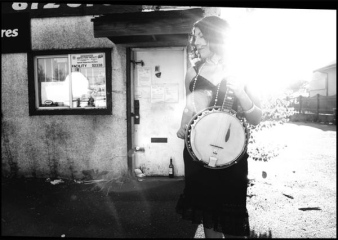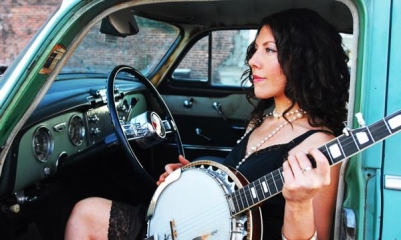
Regardless of where one grows up, the role of music is prevalent enough to embed sentiments of nostalgia into one’s memory of their childhood. Whether it is predominantly exposed as cultural tradition or commercialized exploitation are the variables that depend on one’s location, but music’s cognitive effect is something that is definitive for all. Growing up in an urban, rural, or even isolated location certainly affects one’s lifestyle, but music tends to be universally relatable in that its effects have no bearing on one’s specific location. This is especially true for artists, as we have seen success stories originate from both the open countryside and bustling city streets. The artistically inclined struggle to avoid the allure of art’s impact and presence; they see its participatory effect as being either an escape from reality or a path toward the bright lights of stardom. Artistic fulfillment is derived from one’s reasoning for participating in musical practice, and whether it is to escape grim reality or to become etched in the history books is a motivational basis that tends to vary based on the individual. Pinpointing a specific artist’s true intentions for making music can be highly erroneous though, since there are so many possibilities. But if one pursues music as a gesture of adoration for the art in general, it is an act that has no geographical or cultural boundaries.
The appreciation of an art seems so sincere and instantaneous that the sociological effects appear to be either nonexistent or extremely minimal. There are certainly some implications – like how living in a wealthier area allows for more accessibility to the arts – but one’s level of receptiveness toward art is something that cannot be tampered with, regardless of where one lives. Tamara Nile grew up in a tiny cabin on Galiano Island, a British Columbian island with barely over 1,000 full-time residents. While most contemporary amenities were available to her, it is evident that living on an island has its fair share of artistic disadvantages. There is a good chance that not one decent band would inhabit an island of 1,000 people, if one band even existed at all. The lack of a music scene must have certainly subdued any artistic urges from younger residents, right? Not necessarily. As I mentioned before, I do not believe these sociological factors to have little bearing on one’s interest in art or their motivational ideology for pursuing it. Tamara Nile recently played in front of a very receptive festival audience, with the number of people in the audience being 20x more than the population of her native Galiano Island alone. She serves as evidence that not all artists are influenced by their surroundings. Some are just born to write damn good songs.

Although Nile lived on a small and somewhat isolated island, it would be unethical to not provide credit to her father, a multi-instrumentalist sidewalk entertainer. He travelled throughout North America and Australia mostly, with Nile tagging along ever since the young age of six. His influence on molding her prevalent appreciation for the arts is evident, and this in addition to her natural ability are the factors that make her one of the most impressive folk artists I have featured this year. Nile began trying her own hand at songwriting in her early teens and moved to Vancouver to pursue a music career at the age of 19. Her debut album, At My Table, was released shortly thereafter in 2006 to very positive reviews. Gems like “Trees” and “Get Together” showcased her modernistic take on folk, which combined typical acoustical folk instrumentation with unconventionally flexible rhythm sections, time signatures, and melodic accompaniments in the vein of shrieking electric guitars and howling vocals. It was a style that proved remarkably unique, treating the young songwriter to a plethora of festival appearances and awards. She was voted the “Best New/Emerging Artist” at the Canadian Folk Music Awards, indicative of her interesting take on folk music and its positive effect.
Nile’s newest release, The Cabin Song, is an EP that serves as a preview of her upcoming full-length, set to be released in early 2010. Despite being a short release, the seven songs (two of them being short interludes) on The Cabin Song are all highly impressive in their own right and do a remarkable job of showcasing Nile’s grittier, edgier, and more eclectic style of folk. There are some familiar folk elements, like the electric twang and acoustical accompaniment on “Cabin Song”, but subtleties that involve rhythmic and melodic elements are vital to the appreciation of Nile’s style. “Cabin Song” has a great feel to it with its brisk acoustics, but the throwback “Reverie” does even better with its revolving structure and sporadic percussion. “Reverie, come dance with me,” Nile pleads during the chorus, set afire by the frantic percussion. A concise banjo solo follows, and allows the old-fashioned and modernistic to fuse at least for a slight moment. This is what Nile does so well all throughout The Cabin Song though, so this is not the sole example. “Reverie” touts its heavy dub-bass line over evolving percussion and Nile’s ardent howls, but other tracks like the colorfully engaging “Sunrises” also achieve similar stylistic heights. For someone with Nile’s ability and appreciation for stylistic diversity, it is not surprising that growing up in a small town was not an obstacle in her triumphant path to success.
——————————————————————————————
[audio:http://mineorecords.com/mp3/nile-rev.mp3]——————————————————————————————
[audio:http://mineorecords.com/mp3/nile-cab.mp3]——————————————————————————————
[audio:http://mineorecords.com/mp3/nile-sun.mp3]——————————————————————————————






i work closely with t. nile and while i appreciate this article in many ways, and thank you for your positive comments, i feel i must correct a few of your points. tamara grew up surrounded by art and music and was playing it from a very young age with her family and surrounding community.
galiano has produced numerous writers and musicians; order of canada receiver jane rule, dorthy livesay, critically acclaimed songwriter indio saravanja, and many others. proportionally galiano island has produced a high number of artists for it’s modes population. this surely has some bearing on tamara’s abilities and talents. thanks for the article and readers please be aware that the new cd will be available for download off of as of june 9th.
all the best,
denise g.
two corrections on previous comment “modes population” should read “modest population” and her cd is available ad of june 9th on tnile (dot) com
Hi,your music is ……^0^